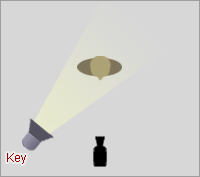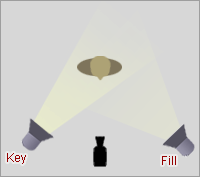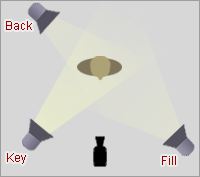3 POINT LIGHTING

Key Light
This is the main light. It is usually the strongest and has the most influence on the look of the scene.
It is placed to one side of the camera/subject so that this side is well lit
and the other side has some shadow.
It is placed to one side of the camera/subject so that this side is well lit
and the other side has some shadow.

Fill Light
This is the secondary light and is placed on the opposite side of the key light.
It is used to fill the shadows created by the key.
The fill will usually be softer and less bright than the key.
To acheive this, you could move the light further away or use some spun.
You might also want to set the fill light to more of a flood than the key.
It is used to fill the shadows created by the key.
The fill will usually be softer and less bright than the key.
To acheive this, you could move the light further away or use some spun.
You might also want to set the fill light to more of a flood than the key.

Back Light
The back light is placed behind the subject and lights it from the rear.
Rather than providing direct lighting (like the key and fill), its purpose
is to provide definition and subtle highlights around the subject's outlines.
This helps separate the subject from the background and provide a three-dimensional look.
Rather than providing direct lighting (like the key and fill), its purpose
is to provide definition and subtle highlights around the subject's outlines.
This helps separate the subject from the background and provide a three-dimensional look.













.jpg)
.jpg)
.jpg)



.jpg)
.jpg)
.jpg)
.jpg)




.jpg)





.jpg)